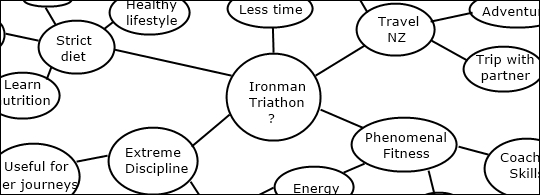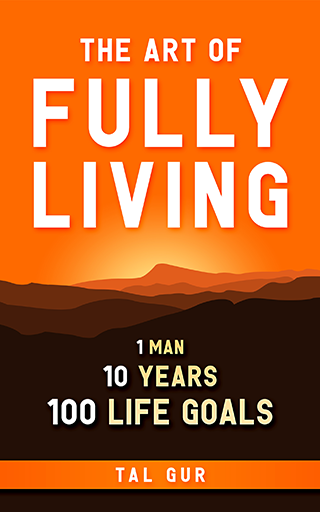Setting Yearly Goals
Have you ever set a big goal for yourself, but ended up feeling unmotivated and stuck as time went by?
My hand is up. It happened to me in the past and I've seen it happen to many others too.
When we set a big goal, we're often too quick to pursue it, not considering the already overloaded schedule we routinely have, the sacrifices we might have to make, and the elements that already work well in our lives.
Often, we just need to pause for a while, reaffirm our commitment, adjust our routines and lay some groundwork to carry us forward in our journey.
Identifying Your Options
Deciding on a yearly goal is not always easy, especially when there are several directions to go in and they all feel important.
I usually brainstorm on a piece of paper and push myself to generate a certain number of ideas. If I’m stuck, I use a few questions to get me thinking. I find myself a quiet place with minimal distractions, and each time I get an idea, I jot it down. This usually works without fail.
Here are some questions that helped me to get started (more questions can be found within my free eBook, "Design Your Dream Year"):
- What are the biggest, most exciting dreams I want to manifest into my life?
- What is my ultimate destination? What is the vision I have for my life?
- What am I passionate about? What am I most excited about in life?
- If anything was possible, what is the first change I would start to make?
- What area of my life can be upgraded and would make the biggest difference?
- For my life to be perfect, what would have to change?
- What do I really, really want...?
Evaluating Your Options
My second step, which is often the hardest one to make, is evaluating which option may provide the optimal path for the year. Some people use a long, drawn-out process of analysis to make a decision, but I find this to be too tedious. I prefer to rely on my gut instinct and trust my intuition to guide me.
What I usually do is simply think about which one of the items on my list would radically transform my life and give me the most benefits. Then I write down the deepest reasons I can fathom why I want to bring this into reality.
If I don’t feel aligned with that reason, I keep revisiting it until I feel a strong emotional resonance with it.
Clarifying Your Goal
Clarifying your yearly goal is fundamental to maintaining motivation and to making sure that your goal has enough emotional appeal to strike your inner desire.
It makes it easier to know when you've reached your goal and when it's time to stop. Without clear goals, you can wander aimlessly and most likely end up losing interest or becoming distracted.
By "clarifying your goal", I mean asking yourself a few basic questions about your new direction. Such as:
- What exactly do you want to accomplish?
- What are the biggest rewards from pursing your goal?
- What is at stake if you don’t achieve it?
- Would working toward your goal bring you satisfaction?
- How important is it for you to achieve your goal?
You’ve probably heard the acronym “SMART goal” before. (SMART goals are Specific, Measurable, Attainable, Realistic, and Time-based). I usually use this approach when I set smaller goals later in the process, but I find it too rigid and uninspiring at this point. I find that this method puts the concept of goal-setting and dream-attainment in a linear framework that works only on the left side of the brain.
As an alternative, I clarify my chosen goal by being specific about what the goal means to me and by considering the major rewards along the journey. When goals are both extremely significant and rewarding, they create a greater impact on our minds and provide a long-lasting source of energy.
A more “right brain” tool that can be effectively used for identifying rewards (and obstacles) is drawing a consequence map diagram. You start with your goal as a center node and draw it in the middle. You then brainstorm different kinds of consequences and draw them in subsequent nodes. That’s pretty much it.
Below is an example of a consequence map for my decision to participate in an Ironman triathlon race.

I personally find Consequence Mapping extremely useful for big decisions that contain a lot of uncertainty.
Laying the groundwork
Once you’ve made a decision on which goal to pursue, your first instinct may be to tackle your goal right away. This can work well with smaller and lower risk goals, but large goals, by their very nature, often need some more groundwork.
Are you committed to your life goals?
- How much time or resources do you have available for your goal?
- Would you need to acquire new skills or knowledge?
- How would you find motivation and discipline when you most need it?
- Do you have the right people or support group around you to succeed?
This year, for example, I allocated a whole week to laying the groundwork needed for my goal. I went on an information diet to amp up my productivity and focus. I unsubscribed from all my daily emails, Facebook groups and mailing lists (I now only follow those who contribute directly to my journey), and I gave up on some freelance work to free up even more time.
Whatever groundwork you need to make, whether it's within yourself or with others, I highly recommend you take the time and do the work.
Planning Your Goal
While working in the corporate world I've noticed how frequently top managers focus on the immediate task in front of them, rather than plan ahead. They mistakenly regarded being busy as being effective.
My belief is that your commitment to your goal is represented in your planning. More specifically, it is represented in your well-intentioned schedule and your newly planned action steps.
The most effective way I know how to tackle a big goal is to break it down into more manageable steps. Smaller projects are less scary and when you see that you are taking small steps forward, you will tend to stay motivated.
Setting intermediate goals will also help you mark your progress along the trail. Achieving these benchmark goals means you’ll have frequent victories and build your momentum with each one you complete.
A goal to start making income online, for example, can be broken into several sub-goals, such as building a blog, creating an information product, increasing your following, building an affiliate network, etc. Each sub-goal can be broken down further into action steps. Building a new blog, for example, can be divided into a number of action steps, such as structuring your initial content, creating screen layouts, building a sitemap, etc.
One important thing that I also recommend in my Design Your Dream Year ebook is to try focusing on one project at a time. Most goal methods do not work because we try to change everything all at once. This is quite tempting, but in my experience, it translates into mediocre outcomes. When you try to take on many goals at once, you simply spread your energy and focus thin.
Set Ongoing Habits
One step that is almost always ignored, and yet has a tremendous impact on whether or not you’ll achieve your goal is forming supporting habits. You can harness your willpower each time you start a task, but if you do it too often, you’ll eventually burn out and revert back to the same behavioral patterns. Not surprisingly, it has been reported that 95 percent of people who try to lose weight on a diet regain it. Self-control is a limited resource and needs to be treated as such.
This is where habits come in.
Habits help us to continue working on our goals even when we are not motivated. They allow us to transition through our day on autopilot and conserve our limited energy. By harnessing the more primitive part of the brain in which habits are formed, you’ll have the opportunity to make lasting changes.
If you’re interested in forming habits this year, take a look at the last step in my ebook, and decide what works best for you. For better or for worse, we are creatures of habits. Take advantage of it.
Take ACTION
None of the information in this post really matters without you taking action. In particular,
1. Choose a goal that you aim to achieve within 30 days.
2. Determine how you will know that you've achieved your goal.
3. Brainstorm what resources you'll need to achieve it.
One last piece of advice: We often expect too much too soon and then get discouraged when results don’t come right away. Commitment does not mean rushing toward your goal, but rather, taking ample time to figure out a plan, build supporting rituals, and lay the groundwork that is so needed in order to achieve your goal.
Live out your dreams,
Tal Gur
P.S If you found this post helpful, please forward it to someone you love and click the sharing buttons below. The world is a better place when people actively follow their dreams.
* If you’re seeking extra motivation and inspiration on your journey of personal growth, I recommend taking a look at my SMART growth goals page, This page offers thousands of goal ideas that can assist in the establishment of new aspirations and the attainment of greater heights in one's life. In fact, it was instrumental in my creation of a list of 100 goals, which I pursued for a decade.
Chief Editor
 Tal Gur is an author, founder, and impact-driven entrepreneur at heart. After trading his daily grind for a life of his own daring design, he spent a decade pursuing 100 major life goals around the globe. His journey and most recent book, The Art of Fully Living, has led him to found Elevate Society.
Tal Gur is an author, founder, and impact-driven entrepreneur at heart. After trading his daily grind for a life of his own daring design, he spent a decade pursuing 100 major life goals around the globe. His journey and most recent book, The Art of Fully Living, has led him to found Elevate Society.





















